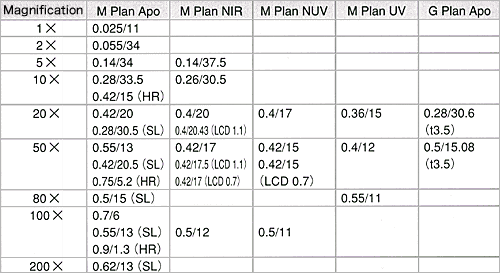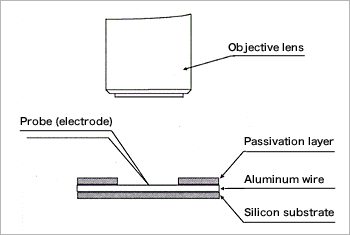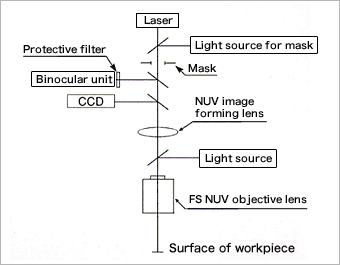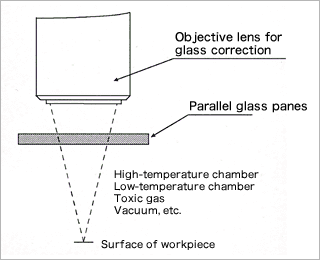- Home
- Technology
- Applied Technologies for Products
- Technical Information

1. Introduction
Optical microscopes are trusty old devices, used since the mid-16th century for viewing enlarged images of specimens. As optical equipment with a long history of improvements, optical microscopes have been able to meet various needs in terms of functions and performance features without requiring any major changes in the basic approach of their application. In recent years, micro machine tools have typically used non-contact visual measuring CMMs, microspectroscopes, interferometers, or microscope-equipped lasers, so it is becoming quite common now for such equipment to feature new functions in addition to conventional microscope functions. In addition, the wavelength regions being observed now go beyond the visible region to include infrared and ultraviolet wavelengths. One of the main use restrictions for these devices is derived from the short working distance of objective lens microscopes.
This document describes MITUTOYO's "FS Objective Lens Microscope Series", which features a long working distance, wide-ranging operation that includes the infrared and ultraviolet regions, and enhanced ease of operation.
2. Development Background and Goals
Advances in semiconductor integration have been made with almost dizzying speed in recent years, and with this trend has come new demands to take inspection operations from the micron level to the sub-micron level. At the same time, industries are seeking to develop new high-performance objective lenses in objective lens microscopes, with features such as improved operability, higher resolution, and a long working distance. To meet the challenge of providing both a large numerical aperture and a long working distance, MITUTOYO has reconsidered the 45-mm parfocal distance standard for objective lens microscopes, and has widened the scope of lens design to include parfocal distances up to 95 mm. As a result, MITUTOYO has developed new high-performance objective lens microscopes that feature higher magnification, a larger numerical aperture rating (for higher resolution), and a longer working distance. (See Figure 1.)
3. Features of FS Objective Lens Microscope
The optical system in FS microscopes is an infinity-correction optical system that uses both an objective lens and an imaging lens (tube lens) to generate images. Aberration correction is performed independently on the objective lens and imaging lens. This optical system is the main feature of the FS Objective Lens Microscope Series of products. Consequently, these products can be used not only as they are, but as part of an expandable system in which users are able to set the imaging lens as they please to incorporate the microscope into their own equipment. MITUTOYO offers several types of imaging lenses, as well as the VMU Series of microscope units equipped with this optical system, the FS70 Series and VM-ZOOM Series of high-powered microscope units, the FS110T inspection microscope, and the MF Series of high-magnification measuring microscopes.
 |
|
Figure 1. Comparison of Objective Lenses with Different Parfocal Distances |
Both of these systems make use of an ultra-long working distance objective lens, which makes possible features not available in previous microscopes and, as such, are unique microscope systems with distinctive operability features.
Generally, when the design for an objective lens calls for a longer working distance, various types of aberrations tend to occur. This poses a problem for optical design, since chromatic aberration is especially likely to occur. In the M Plan Apo Series, apochromat with corrected color aberration in a wide part of the visible range has been achieved by selectively using anomalous dispersion glass and ultra-low dispersion glass with a low refractive index. The wavelength-based refractive index in these types of glass differs from that of ordinary optical glass. In particular, M Plan Apo Series products are able to provide a sharper image, thanks to this correction of lateral chromatic aberration and astigmatism.
4. FS Objective Lens Microscope Specifications
FS objective lens microscopes are available in the product series listed below. All boast a long working distance and lens sets with distinctive features.
|
Ο |
M Plan Apo Series |
Ο |
M Plan NIR Series |
|
|
BD Plan Apo Series |
|
LCD Plan NIR Series |
|
Ο |
M Plan NUV Series |
Ο |
M Plan UV Series |
|
|
LCD Plan NUV Series |
|
|
|
Ο |
G Plan Apo Series |
|
|
The features and specifications of these product series are described below.
4-1. M Plan Apo Series / BD Plan Apo Series
The M Plan Apo Series are objective lens microscopes to be used with the visible light spectrum for bright field observations while the BD Plan Apo Series of microscopes are for dark field observations. In addition, there are the "M Plan Apo SL" Series and the "BD Plan Apo SL" Series of models that are designed for long working distances.
4-2. M Plan NIR Series / LCD Plan NIR Series
Products in this objective lens series are able to correct chromatic aberration throughout the visible light spectrum and the near infrared region, as they feature an ultra-long working distance objective lens with enhanced functions that boost higher transmissivity in the near infrared region. The LCD Plan NIR Series also features a glass cover (thickness t = 1.1 mm or t = 0.7 mm) specially designed for the LCD.
4-3. M Plan NUV Series / LCD Plan NUV Series
Products in the M Plan NUV Series use optical glass that improved the quality of transmissivity in the short wavelength region, and they are able to correct chromatic aberration throughout the visible light spectrum and the near ultraviolet region. An anti-reflective coating has also been developed for these products, to help maintain high transmissivity up to the short wavelength region. Like NIR Series products, these products uses an objective lens (t = 0.7 mm) that is specially designed for LCDs.
4-4. M Plan UV Series
Products in this objective lens series feature the latest design in the FS objective lens microscope series, and since last year have been offered in a series of 80X, 50X, and 20X models. To maintain transmissivity even in the ultraviolet region, MITUTOYO has replaced ordinary optical glass with fluorite and synthetic quartz as lens materials. An anti-reflective coating has also been developed for these products.
4-5. G Plan Apo Series
When using an objective lens to observe the surface of a workpiece, if a thick glass cover is placed over the workpiece, image's contrast may be reduced sharply by the large amount of spherical aberration produced by the glass cover. This effect is especially great when using high magnification or an objective lens that has a high NA rating. The G Plan Apo Series is an objective lens series developed specifically for observations made through a thick glass cover. Since having an objective lens with a long working distance is an absolute requirement when observing workpieces through a glass cover, this series is the one that makes the most of FS objective lens features. Three types of products are offered: a type for glass covers from 2 mm to 5 mm thick (t = 3.5 mm, BK-7 is standard), a type for fixed glass thickness, and a continuous aberration correction type for thickness of 2 mm to 5 mm (uses an adjustable internal lens).
 |
|
Table 1. Specifications of FS Objective Lens {NA/Working Distance (mm)} |
5. Typical Uses of Ultra-long Working Distance Objective Lens
5-1. Semiconductor Defect Analyzer (Prober Station)
When a prober station (a type of semiconductor defect analyzer) is used to perform micromanipulation, a probe (electrode) must be inserted into a semiconductor's aluminum wires under a microscope to perform a conductivity test. (See Figure 2.)
This type of operation can be very difficult if the objective lens' working distance is too short. Consequently, this is one application field where an Ultra-long working distance objective lens is required. For the prober station shown here, MITUTOYO's "FS 70 Series" and "VM-ZOOM" microscope unit can be combined with an ultra-long working distance objective lens series product to achieve maximum performance. Almost all models in the FS Objective Lens Series, including the M Plan Apo,M Plan NIR,M Plan NUV,and M Plan UV models, have features that can be put to effective use in this way.
 |
|
Figure 2. Probing Operation |
5-2. Laser Processing
The most common method for laser microprocessing that uses a microscope is the mask projection method, for which a YAG laser with a mounted microscope is typically used. (See Figure 3.) The first such lasers used only the YAG fundamental wave (1064 nm), but since then second harmonic wave (532 nm), third harmonic wave (355 nm), and fourth harmonic wave (266 nm) versions have been developed, and other versions are likely in the future. In addition, excimer lasers are coming into use as an alternative to YAG lasers. MITUTOYO objective lenses used with these products include the NIR Series, NUV Series, and UV Series. Users can select the laser best suited for the type of process (from thermal processing in the near infrared region to optical processing in the ultraviolet region) and the materials to be used. Since these objective lenses have a long working distance, there is rarely any problem with the lens becoming contaminated by substances evaporated during laser processing. This makes it comparatively easy to handle workpieces that are in a vacuum chamber or gas environment inside the thick glass cover. The ultra-long working distance objective lens is also used to repair semiconductor masks and LCDs. When it is attached to a prober station (as described above) with a MITUTOYO microscope unit attached to the laser port of the "FS 70" or "VM-ZOOM" as a microscope-equipped laser, the laser can be used to peel off a semiconductor's passivation layer to enable probing.
 |
|
Figure 3. Example of Optical System for Laser Processing |
5-3. CNC Vision Measuring Machines
|
Today, measuring instrument manufacturers are announcing and marketing various CNC vision measuring machines equipped with microscope systems and covering with a wide range of specifications. These products offer many popular features that can help reduce inspection labor costs while raising throughput, that enable even inexperienced users to obtain accurate measurements, and that can improve the working environment by eliminating difficult tasks. MITUTOYO has developed an assortment of products in the "Quick Vision Series" and "Quick Scope Series" that support a wide variety of workpieces. These are also products that use ultra-long working distance objective lenses. In the field of vision measuring machines, there is a big demand for objective lenses with long working distance, and especially for MITUTOYO products that support workpieces with large level gaps. Many users have responded enthusiastically to the versatility of these products across a wide scope of measurement applications. |
|
5-4. Observations through Parallel Panes of Glass
MITUTOYO offers the "G Plan Apo Series" as a product series that meets the specifications for this task. However, given the nearly infinite variety of specifications required by users, these products cover a broad wavelength spectrum from infrared to ultraviolet and use a variety of parallel pane materials including not only optical glass but also synthetic quartz, sapphire glass, diamond, and even liquids. Pane thickness ranges from approximately 0.5 mm to over 20 mm, and some users have requested high NA types as well. Applications also vary greatly, from making observations to laser processing, and in many cases these products are used as a condenser lens. As noted above, these user needs are served by the FS Objective Lens Microscope Series products in general. Figure 5 shows some of the things that can be done with an ultra-long working distance objective lens microscope but cannot be done with ordinary objective lens microscopes: observations of workpieces in high-temperature or low-temperature chambers, vacuum chambers, gas-filled chambers, and suspended in liquids. Of course, aberration correction to meet specifications is available in custom-order versions these products, and repeat functions are used to provide suitable optical systems at a reasonable price. One feature of ultra-long working distance objective lenses is the availability of custom order lenses such as these.
 |
|
Figure 5. Observation through Parallel Glass Planes |
5-5. Other
There are many other types of MITUTOYO optical equipment and optical measuring machines that also take advantage of ultra-long working distance objective lens features. Some typical examples are described below.
|
• Hot |
Electron microscope
|
For semiconductor defect analysis and detection of faint light emitted by leaks, etc.
|
|
• Interferometer |
Micro Fizeau interferometer
|
Fizeau interferometer that uses an objective lens microscope
|
|
|
Linnik interferometer
|
Michaelson interferometer uses a pair of objective lens microscopes to provide an optical system for reference optics as well as an optical system for workpieces, and each lens has the same waveform curvature aberration
|
|
• Laser repair device |
This device is used to laser processing repair defects in semiconductor and masks
|
|
|
• Microspectroscope |
This device microscope uses a microscope to measure reflective optical characters in small areas
|
|
6. Conclusion
The "FS Ultra-long Working Distance Objective Lens Series" products described above provide a long working distance for easier operability, a wider spectrum of target wavelengths, and other capabilities not found in ordinary objective lens microscopes. This broadening of the application scope for microscope optical systems has been welcomed by many users.
The FS Objective Lens Microscope Series was developed to meet user needs, and each year various new products are added to this series. MITUTOYO stands ready to continue serving user needs by further expanding the "FS Ultra-long Working Distance Objective Lens Series" in the years to come.

